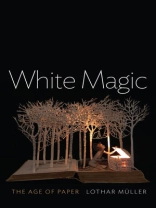Paper is older than the printing press, and even in its unprinted state it was the great network medium behind the emergence of modern civilization. In the shape of bills, banknotes and accounting books it was indispensible to the economy. As forms and files it was essential to bureaucracy. As letters it became the setting for the invention of the modern soul, and as newsprint it became a stage for politics.
In this brilliant new book Lothar Müller describes how paper made its way from China through the Arab world to Europe, where it permeated everyday life in a variety of formats from the thirteenth century onwards, and how the paper technology revolution of the nineteenth century paved the way for the creation of the modern daily press. His key witnesses are the works of Rabelais and Grimmelshausen, Balzac and Herman Melville, James Joyce and Paul Valéry.
Müller writes not only about books, however: he also writes about pamphlets, playing cards, papercutting and legal pads. We think we understand the ?Gutenberg era?, but we can understand it better when we explore the world that underpinned it: the paper age.
Today, with the proliferation of digital devices, paper may seem to be a residue of the past, but Müller shows that the humble technology of paper is in many ways the most fundamental medium of the modern world.
Mục lục
Thanks viii
PROLOGUE The Microbe Experiment ix
PART ONE The Diffusion of Paper in Europe 1
CHAPTER 1 Leaves from Samarkand 3
1.1 The Arab Intermediate Realm 3
1.2 Calligraphy and the Cairo Wastepaper Basket 10
1.3 In Scheherazade’s World 13
1.4 Timur and Suleika 17
CHAPTER 2 The Rustling Grows Louder 22
2.1 The European Paper Mill Boom 22
2.2 Paper, Scholars, and Playing Cards 26
2.3 The Rise of the File: Paper Kings, Chanceries, and Secretaries 31
2.4 The Merchant of Genoa and His Silent Partner 37
2.5 Ragpickers, Writers, and the Pulpit 46
CHAPTER 3 The Universal Substance 52
3.1 Marshall Mc Luhan and the Pantagruelion of Rabelais 52
3.2 Harold Innis, the Postal System, and Mephisto’s Scrap 61
3.3 The World in a Page: Watermarks, Formats, Colors 70
PART TWO Behind the Type Area 79
CHAPTER 1 The Printed and the Unprinted 81
1.1 The Pitfalls of a Formula: ‘From Script to Print’ 81
1.2 The White Page 85
1.3 ‘Found among the Papers …’ 89
CHAPTER 2 Adventurers and Paper 94
2.1 Don Quixote, the Print Shop, and the Pen 94
2.2 Picaresque Paper: Simplicius Simplicissimus and the Schermesser 99
2.3 Robinson’s Journal, Ink, and Time 104
CHAPTER 3 Transparent Typography 108
3.1 The Epistolary Novel’s Mimicry of Letter Paper 108
3.2 Laurence Sterne, the Straight Line, and the Marbled Page 115
3.3 The Fragmentation of the Printed Page: Jean Paul, Lichtenberg, and Excerpts 119
PART THREE The Great Expansion 127
CHAPTER 1 The Demons of the Paper Machine 129
1.1 The Mechanization of Sheet-Making 129
1.2 The Loom of Time, the French Revolution, and Credit 140
1.3 Balzac, Journalism, and the Paper Scheme in Lost Illusions 152
1.4 The Secrets of the Scriveners: Charles Dickens and Mr. Nemo 163
1.5 Foolscap and Factory Workers: Herman Melville and the Paper Machine 168
CHAPTER 2 Newsprint and the Emergence of the Popular Press 180
2.1 The Boundless Resource Base 180
2.2 The Newspaper, the Price of Paper, and the Patrioteer 189
2.3 Émile Zola, the Petit Journal, and the Dreyfus Affair 196
CHAPTER 3 Illuminated Inner Worlds 201
3.1 Wilhelm Dilthey, Historism, and Literary Estates 201
3.2 Henry James, Edith Wharton, and the Autograph Hunt 207
3.3 Laterna Magica: Paper and Interiors 215
CHAPTER 4 The Inventory of Modernity 226
4.1 Typewriter Paper, Deckle Edges, and White Space 226
4.2 James Joyce, Newsprint, and Shears 236
4.3 William Gaddis, the Paperwork Crisis, and Punch Cards 242
4.4 Rainald Goetz, the Mystic Writing Pad, and the Smell of Paper 249
EPILOGUE
The Analog and the Digital 253
Notes 265
Bibliography 274
Image Credits 292
Index of Names 293
Giới thiệu về tác giả
Lothar Müller is editor of the features section of the Süddeutsche Zeitung. He taught general and comparative literature at Berlin Free University and, since 2010, he has been an Honorary Professor at the Humboldt University in Berlin. In 2013 he was awarded the Berlin Prize for Literary Criticism.












